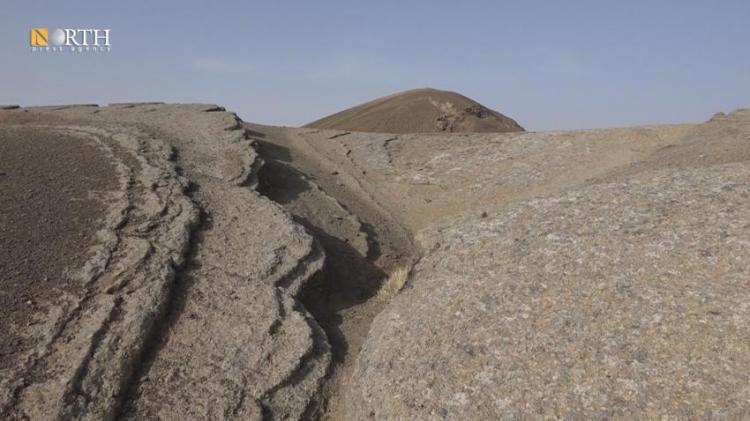Raqqa – North-Press Agency
Mustafa al-Khalil
On the northern side of the town of al-Karamah, 30 km east of Raqqa, lies the al-Manakher volcanic plateau, which rises more than 400 m above the sea level and 200 m above the area around it. Local researchers believe that the Syrian government did not care about it during the past decades, despite the importance of this site.
Al-Manakher plateau dates back to the 4th geological era within the modern long-term geological time, and belongs to the unique Suma mountain range in Syria, according to Ahmad al-Wajid, member of the Syrian Geographical Society, an independent civil society based in Damascus.
Some residents say that the reason for calling the volcanic plateau "al-Manakher" (in Arabic "nostrils"), is because it resembles human nostrils, and the name has been passed on from one generation to another.
Al-Wajid, who is a resident of al-Karamah town and holds a diploma in geography, said: "The wall that surrounds al-Manakher plateau is scientifically called the Suma Wall, and surrounds it on all sides. At the western end of it is a volcanic crater which has been dormant for thousands of years, forming what looks like a sports stadium, that resembles the volcanoes of Indonesia in East Asia."
In his talk with North Press, al-Wajid says he has based his research on various scientific references in earth sciences, including the book "General Geomorphology" which focuses on studying topography and the reasons for its creation and development over time, as well as other references accredited at the universities of Damascus and Aleppo.
He continued explaining the features of the plateau, saying: "On the western side of the plateau, there are grooves, and the depth and size of these grooves increase at the western end due to the west slope facing the western winds."
"The plateau's rocks are hard and basaltic, and are abundant in the western volcanic crater. There is a trench that is scientifically known as "the Sawari" between them and the subsequent volcanoes, which is similar to the trenches in Italian volcanoes and is scientifically called Atrio," he added.
"Despite the unique specifications of al-Manakher plateau in Syria, and in the region in general, it has not been the subject of even the slightest research interest by the Syrian government agencies, much like many geographical phenomena in the Jazira region," al-Wajid said.
Now, nomads living near the plateau, who live in tents, raise camels and sheep, eating what their livestock produce and what they gather from the western, eastern, and northern slopes of the plateau. The plateau has become place for their housing in several stages since the beginning of the Syrian war nine years ago.
Many residents of the towns of al-Karamah and al-Hamrat in the eastern countryside of Raqqa used the black basalt stones of the plateau in building houses and walls surrounding their houses, preferring these stones to the whitewashed stones spread in the Euphrates Valley.
Recently, there was a quarry in the plateau to extract stones, to dig and refine them. The price of one load of the black stone reached SYP 30,000 because of its strength, according to Darwish Muhammad al-Hussein, a farmer from al-Karamah town.
Al-Hussein pointed out that in the past, people in the eastern countryside of Raqqa believed that the grave of Ja'afar Bin Abi Talib is on the western summit of the plateau, which led some sick residents of Raqqa to visit the place and put symbolic sums of money near it, "in order to recover and gain blessings."
During the years of the war in Syria between 2012 and 2017, some of the military groups that successively took control of Raqqa used the plateau as a stronghold due to the difficulty in reaching it.
With the emergence of the Islamic State (ISIS) in 2014 and its takeover of the city of Raqqa, ISIS transformed the western foot of the plateau into their headquarters and a place for torturing prisoners, as one of the residents of the town of al-Hamarat said, preferring not to be named for security reasons. He was previously arrested by ISIS members "because he violated their orders," and they forced him to move the stones "as a deterrent punishment."
Wild animals, such as wolves, hyenas, and herds of deer lived on the plateau, though they disappeared from the area about five years ago due to the large number of the people around them, according to Muhammad Al-Jadie' from al-Karamah.
The plateau is surrounded by "useless and unsuitable" lands for farming because of its black basalt soil, which causes high temperatures, especially in the summer.

